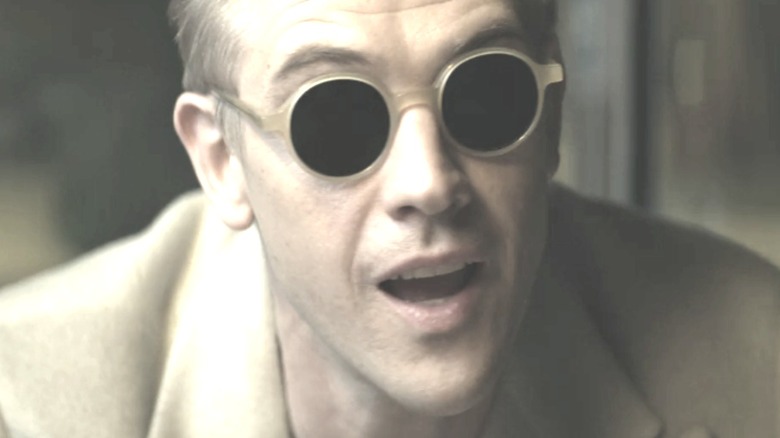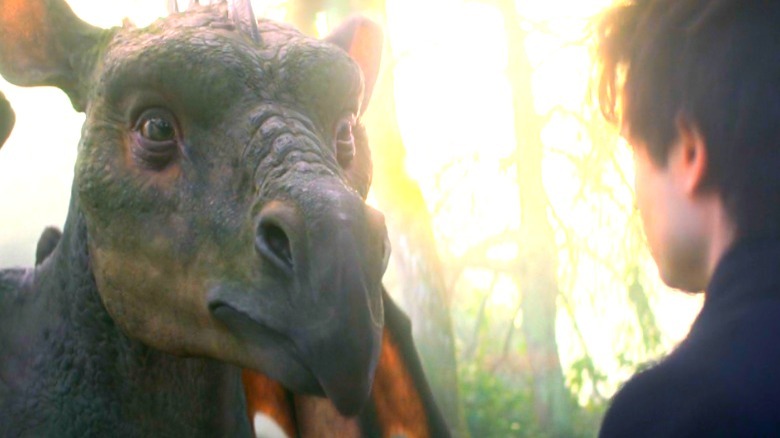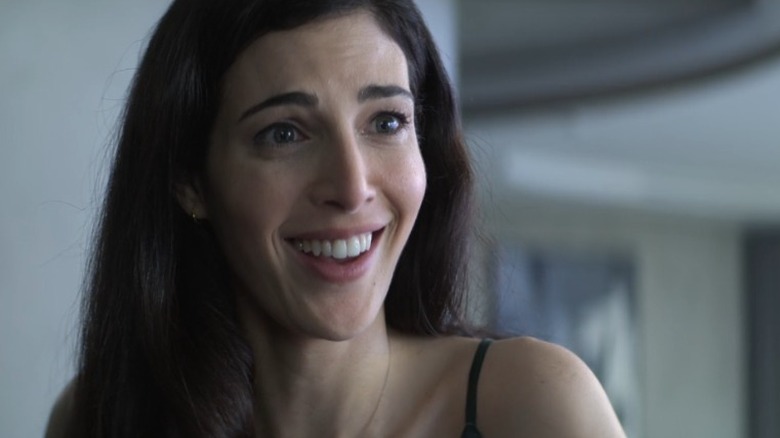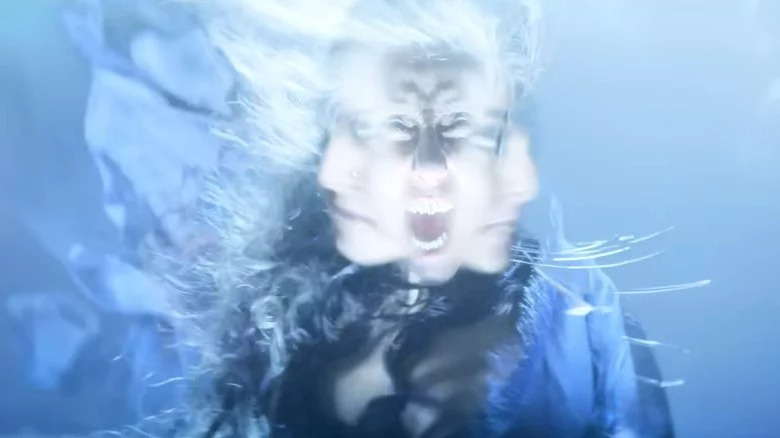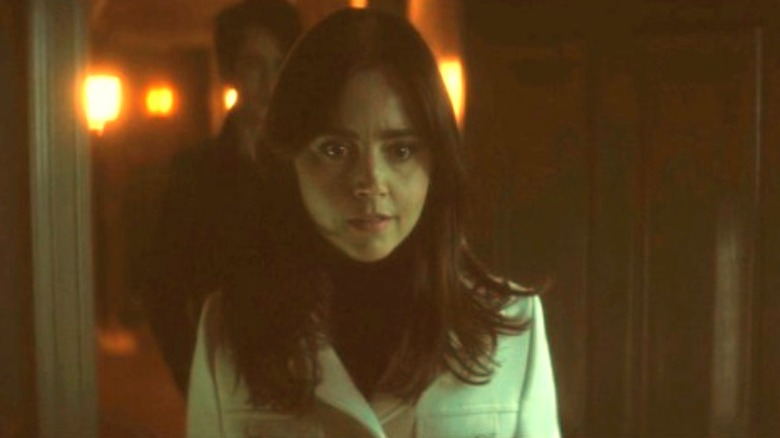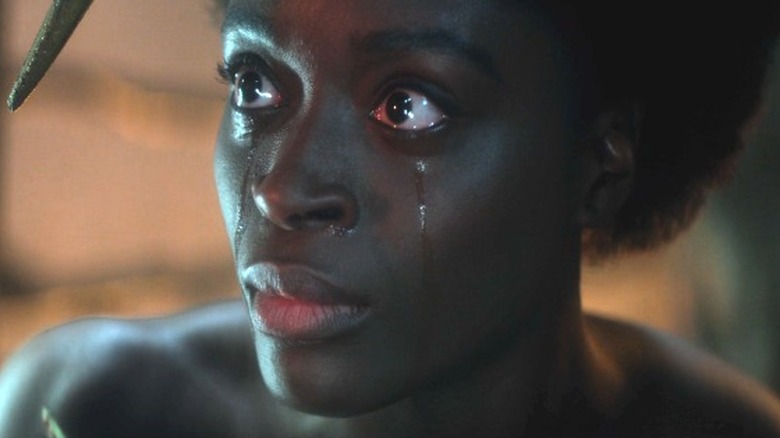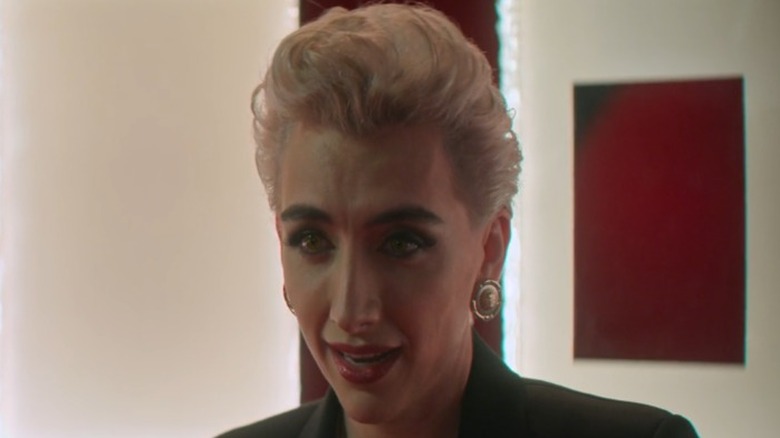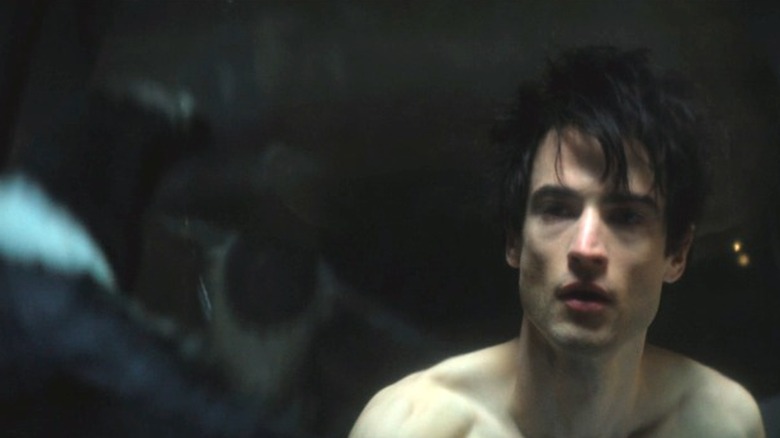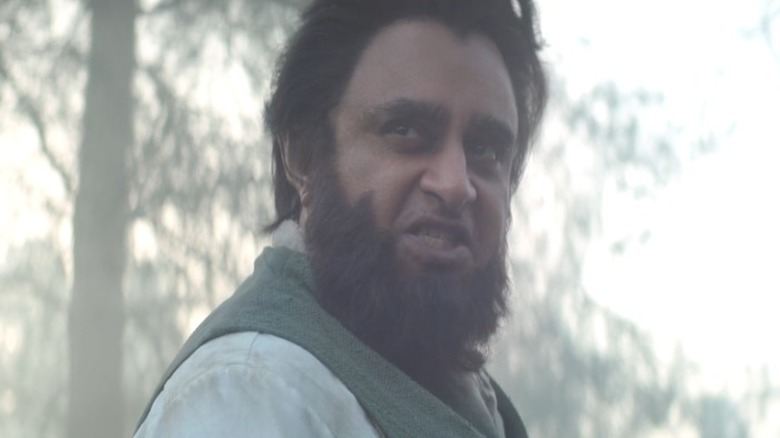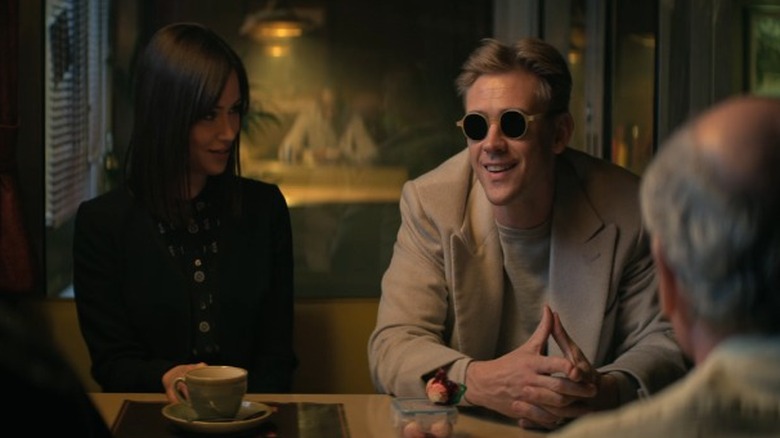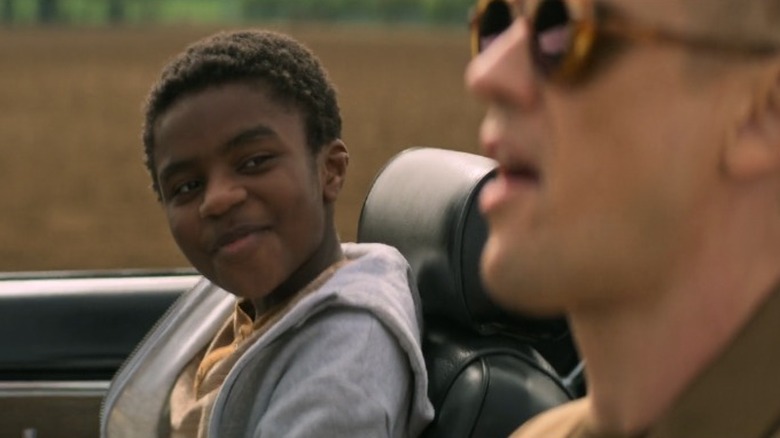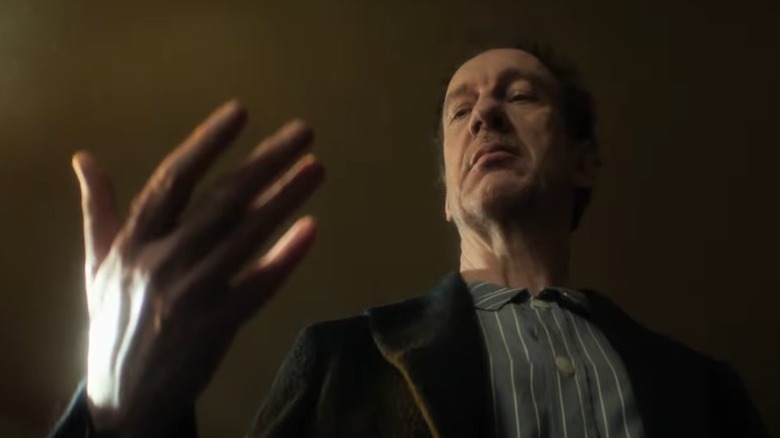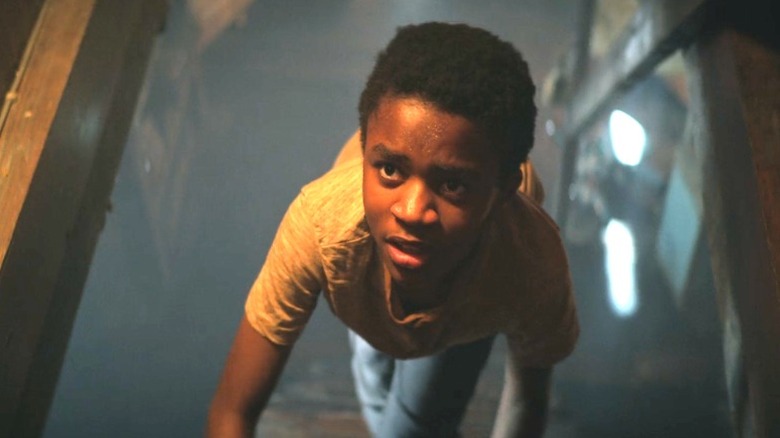The Most Disturbing Moments In Sandman Ranked
Season 1 of "The Sandman" begins with Dream's capture, his escape, and the quest to find his tools of office that consumes the season's first half. Throughout all this, he's troubled by the absence of three Major Arcana of his realm, the Dreaming. One is a locality, named Fiddler's Green, and two are nightmares, by the names of Gault and the Corinthian. Each of these dreams finds its way to the waking world for a different reason and has built up a kind of life there.
Dogging Dream's steps — and Rose Walker's, eventually — we find that Corinthian is terrified that a freed Dream will uncreate him. Before that final confrontation, however, he gets away with a lot of darkness and mayhem. He's certainly not the only monster in the story, but he's the most dashing — and, according to hundreds of serial killers, the most inspirational.
However, it's not just the Corinthian that poses a threat. Human horrors, dreams, nightmares, and some cruel twists of fate are in store for our characters, heroes and villains alike. Here is our ranking of the most disturbing scenes in "The Sandman" Season 1.
12. The fate of Gregory (Imperfect Hosts)
The Dreaming is more than just Dream's realm– everything in it contains a little bit of him. That's why his first act on returning home after 100 years is to consume the life of a willing sacrifice: the adorable Gregory the gargoyle.
We don't learn much about Gregory before his demise, although he had his own house in the yard and seemed to love playing fetch. His keepers, Cain and Abel, both loved him in their own ways. We grow to love him a little bit while we're watching, despite not having long to spend in his presence.
Dream is capable of a lot of ruthless behavior, often exhibiting cruelty and coldness. Much of the season, and the story, are about Dream atoning for some of his less-proud moments. However, taking Gregory's unique life to get his power back isn't one of those times. It's a necessity, as everything else Dream has made is fading away. We could even speculate the reason Gregory's held on as long as he has is because of his caretakers' love in Dream's absence. Sadly, Dream's return spells the end for our groaning gargoyle friend.
11. Lyta's pregnancy (Playing House)
Some of our biggest unanswered questions from Season 1 are about the future of Lyta Hall and her strange child. Why was her pregnancy instantaneous? How did it happen at all? Why did Morpheus lay claim to her baby, and what's his plan for the child?
We won't know the answers to these questions for a while, probably not until Lyta's son is at least three years old. So there's plenty of time to ponder.
Lyta Hall is a devoted friend to Rose Walker, even perhaps a surrogate mother in some ways. Lyta accompanies Rose to England to meet her mysterious benefactor and seems to be recovering well from her husband's recent death. She's sweet, a little naive, and very glamorous.
To see her physical body changed overnight, impregnated by the weird magic of the vortex, is very strange. Even though Lyta and her husband Hector's ghost are both overjoyed at this development it's more than a little unsettling to watch from the outside. Instant and fast-paced pregnancies are rarely a good thing, especially in fantasy TV.
10. The Triple Goddess (multiple episodes)
One thing you might find a little confusing about "The Sandman" is the triple appearance of the Triple Goddess in her guise as the Fates. These mythological entities are three faces of a goddess that can show up in a myriad of ways. Season 1 gives us the Fates at three particular crossroads. First, Dream invokes them with a ritual when he regains the Dreaming, later they appear to John Dee in the diner in "24/7," and eventually Rose Walker finds them in a broom closet.
In this story, the Goddess presents as three women of varying races and ages. The Maiden is young and associated with the color white, the Mother is childbearing age and associated with the color red, while the Crone is black. In the Dreaming we get three British-accented beauties, perhaps the Fates' most honest form, but in the real world they are portrayed by murder victims (with John Dee) and by three denizens of an elder care facility (with Rose).
Drawing from global and modern mythologies, Neil Gaiman's Fates are faces of earthly divinity and as powerful as the Creator in his Silver City. They're unknowably old, wise, and terrifying. The Maiden is known to make the threads of our lives, and the Mother to weave them into stories. However, it's the Crone that decides when it's time to close up shop.
9. Constantine's ex (Dream a Little Dream of Me)
The worst terrors in "The Sandman" are definitely possible in the real world, as we'll see. However, the case of Johanna Constantine's ex is horrifying in its own way. Having been loved and left by Johanna, Noelle hocked some of her magical belongings but kept Dream's dust. That's right — she steals the Sandman's literal sand!
Unfortunately, it's not really meant for human use, just like the ruby John Dee uses for his crimes. In this case, the dust and its power create an addiction in TK, and she spends Noelle's years luxuriating in its fantasies. She's destroyed by it and left a husk of a person who is close to death. In fact, Dream explains, the dust is the only thing keeping her alive. Luckily, Johanna gets a moment to say goodbye.
Johanna could be a great ally to Dream if it weren't for her curse. Though some lovers make it out alive — Kit Ryan, her Irish love, is one fan favorite who left Constantine safely behind — most everyone Johanna cares about will eventually die and probably get pulled into Hell. Still, considering Dream's troubles by the end of the season, it's possible only Johanna will be able to help when Hell does come calling.
8. The damned in Hell (A Hope in Hell)
One creepy detail in the show's depiction of Hell is the way so much of the architecture and industry are created by the suffering bodies of the damned. Walls and outcroppings of naked stone bodies writhe, even creating the great gates and throne room of Lucifer's palace. Even the demons that run the place for him all seem maimed in some way. Still, that's not the only way someone can be punished in Hell.
Viewers meet a young woman named Nada, who perceives Dream as a young Black man, and the two discuss their mysterious past. She's in Hell at Dream's bidding, and he's not ready to forgive her quite yet. This serves as a reminder that we are seeing just one facet of Morpheus when we see Tom Sturridge, the actor who plays the King of Dreams. We also learn that he's capable of great cruelty.
By the end of Season 1, Dream has been through a lot. Conversations with his siblings Death and Desire convince him that it's the role of the Endless to serve sentient beings, not to rule over them. Beyond that, they shouldn't consider themselves above or separate from them. Who can say whether coming face-to-face with Nada didn't help him change his mind?
7. The golden-eyed man (The Doll's House)
A disturbing twist in the comic is a little cleaned up within the show, as the series originally discussed Unity's sleeping pregnancy as purely an assault. In the show, Unity describes her golden-eyed man in loving tones, clearly relishing the time they spent together. That's only fair, however, as plenty of Desire's victims find themselves obsessed or worse.
Of course, we know there's no romance here. Desire seduces Unity in her coma for one reason only — the destruction of their brother, Dream.
The actor Mason Alexander Park told Winter Is Coming that Neil explained to them that the whole story should be tellable from Desire's viewpoint. They are the hero of their own story, as are we all. As with Death, Hob Gadling, and the Corinthian himself, it might benefit us to take a walk in each of their shoes.
Well, maybe not the Corinthian. Still, there's definitely a story here about Desire, who fulfills their purpose with a devouring dedication.
6. The death of Jessamy (Sleep of the Just)
A first encounter between Dream and one of his ravens is a rare occasion since he only has one at a time, and they spend decades, if not centuries, in his service. The excitement of this first meeting is lessened somewhat by the little time we spend with Jessamy, who ingeniously burns down Fawney Rig, where Dream has been held for 100 years. She zooms past the owner of the house, grabs a match from his stash, lights it against the door while in flight, and burns the place to the ground.
Sadly, Jessamy's victory is uncertain. She pecks at the glass that keeps Dream jailed until a single gunshot from Paul leaves her dead in front of Dream, one more cruel twist of the knife that will earn the Burgess family all kinds of punishments.
Jessamy stands out among Dream's ravens thanks to her white ruff, which rings her shoulders all the way around and gives her a softer texture. We don't know the circumstances of her arrival in Dream's service or her transformation into a raven, although we know that at least some ravens were visitors who died while they were in the Dreaming. In the comics Lucian (here Lucienne) the librarian was once a raven, too, which leads us to wonder what came before that.
5. Cain and Abel (Imperfect Hosts)
Lots of the building blocks of these early stories come from the extensive cast of characters outlined in DC's horror comic heyday. Before the Comics Code outlawed lots of horror tropes, DC horror comics reigned supreme. Cain and Abel, of the respective House of Mystery and the House of Secrets, have long been part of the DC horror comics picture, and "The Sandman " revisits one of their most famous storylines.
The first murder of all time is also the first murder we see on the show — but certainly not the last! Viewers get a front-row seat to the story as it plays out. Cain is once again the first murderer, while Abel reprises his role as the first victim. The moment comes with little warning, as a suddenly angry Cain stabs his brother with a pitchfork. It's a shocking incident after the tenderness of the men's farewells to Gregory the gargoyle.
4. Three collectors (The Doll's House)
Darkly funny and charismatic, the three serial killers who make up the annual Cereal Convention planning committee are inspired and motivated by the bloody history of the Corinthian — as are all serial killers in the world of "The Sandman."
The silly, terrifying trio find themselves in a pickle when the famous Family Man, their guest of honor, vanishes. The Good Doctor, Nimrod, and Fun Land are very different in appearance, but they all love to kill! Which is what makes their group killings so upsetting.
First, the trio attacks victims for their eyeballs to get the Corinthian's attention. Then they team up with him to kill a blogger who has infiltrated the Cereal Convention. In some ways, this killing is the worst murder to watch, especially since it starts with a pretty heavy makeout between the Corinthian and the poor man in question.
3. The Corinthian (multiple episodes)
The Corinthian was created to be a dark mirror of everything humanity can't accept about itself. When Dream uncreates him at the end of "The Sandman" Season 1, it's because, in some ways, he created him too well. To Dream, the Corinthian's desire — to stay in the real world and keep killing people — is unbelievably crass. But he can't blame the nightmare for it — he just has to solve the problem.
In this case, Dream's problem is simple: Not only is he trying to recreate his original quest by searching for the Major Arcana while he keeps an eye on Rose Walker, but he is making up for past mistakes. Finding the Corinthian and eventually robbing the Collectors of their self-mythologizing is all in a day's work, and Dream deals with him as quickly as possible. He takes the Corinthian apart and gives the tiny skull of his essence to librarian Lucienne.
The Corinthian has hungry mouths for eyes, a funny accent, and an easy charm. All three of these are useful in his vocation, which is hunting people and eating their eyes. In some ways, he's the perfect killer, as he is handsome and has an easy charm that pulls you in. He's also a literary reference to the tragic Oedipus myth, as he is from Corinth and blinded himself after killing his father.
2. The diner massacre (24/7)
Probably the darkest setpiece in the season, if not the whole story, "24 Hours" is a bona fide classic. John Dee, a broken and troubled man, arrives at a diner and begins to unravel the lies of those he encounters there using a powerful ruby he stole from his con-woman mother by making dreams real.
In the show, it's difficult to reconcile John Dee's final madness with the somewhat brighter ending to the previous episode, when he shows kindness to his driver Rosemary. By the end of things, however, there are nails through hands, limbs chopped off, all kinds of sex, five dead bodies, and a woman who has blinded herself. Disturbing encounters, memories, and admissions crowd the hour.
The show has improved on the source material by making John Dee a more active antagonist rather than someone you might forgive for being overwhelmed by the ruby's power. John Dee says the deluded people in the diner, and the King of Dreams himself, are all bound by lies, and he claims to be helping them by exposing their secrets. The fact that they tend to die is just an unfortunate flaw of his design.
For Dream, it's more than just another battle. His quest through the show's first five episodes has taught him that he lives by some unexamined rules, and soon his sister Death will remind him of the need to change or die. He's closer to the truth than he has been in millennia when he meets John Dee. When he deals with Dee's threat, it's a relief not just because we're rooting on Dream's behalf but because of every terrible thing John Dee's done.
1. Jed's real life (Playing House)
In a story filled with nightmares, serial killers, and dream vortexes, there's nothing quite like the feeling of helplessness and horror we feel when we find out where Jed's been all this time. Whereas the monstrosities of something like "24/7" or "Collectors" could technically happen in the real world, they're a heightened reality. On the other hand, Jed's situation — locked in the basement by an abusive uncle and swarmed with rats — is almost too real.
While Jed is under the influence of the sweet nightmare Gault, he has some amount of respite as a superhero in his dreams. Whether hugging his sister or fighting nightmare monsters as the ersatz Sandman, Jed's adorable and we want him to be safe. However, the story puts him through a lot before he gets his happy ending. Nobody wants to see a child imperiled or endangered, but especially not one as sweet and funny as Jed. That's just one reason his situation is so desperate.
Sadly, bad foster home situations aren't anything new in this world or the world of "The Sandman." The very banality of the evil here is what makes it so nightmarish. Jed and Rose will eventually reunite, and their Kincaid inheritance will ensure they are eventually taken care of. Still, that doesn't make it any easier to watch as he is foiled in his increasingly desperate escape attempts.
